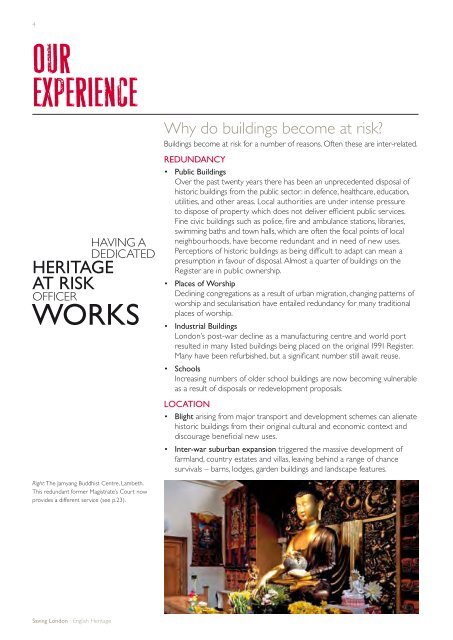Saving London - English Heritage
Saving London - English Heritage
Saving London - English Heritage
You also want an ePaper? Increase the reach of your titles
YUMPU automatically turns print PDFs into web optimized ePapers that Google loves.
4<br />
OUR<br />
EXPERIENCE<br />
Why do buildings become at risk?<br />
Buildings become at risk for a number of reasons. Often these are inter-related.<br />
HAVING A<br />
DEDICATED<br />
heriTAge<br />
AT riSK<br />
W OFFICER OrKS<br />
redundAnCY<br />
• public Buildings<br />
Over the past twenty years there has been an unprecedented disposal of<br />
historic buildings from the public sector: in defence, healthcare, education,<br />
utilities, and other areas. Local authorities are under intense pressure<br />
to dispose of property which does not deliver efficient public services.<br />
Fine civic buildings such as police, fire and ambulance stations, libraries,<br />
swimming baths and town halls, which are often the focal points of local<br />
neighbourhoods, have become redundant and in need of new uses.<br />
Perceptions of historic buildings as being difficult to adapt can mean a<br />
presumption in favour of disposal. Almost a quarter of buildings on the<br />
Register are in public ownership.<br />
• places of Worship<br />
Declining congregations as a result of urban migration, changing patterns of<br />
worship and secularisation have entailed redundancy for many traditional<br />
places of worship.<br />
• industrial Buildings<br />
<strong>London</strong>’s post-war decline as a manufacturing centre and world port<br />
resulted in many listed buildings being placed on the original 1991 Register.<br />
Many have been refurbished, but a significant number still await reuse.<br />
• Schools<br />
Increasing numbers of older school buildings are now becoming vulnerable<br />
as a result of disposals or redevelopment proposals.<br />
LOCATiOn<br />
• Blight arising from major transport and development schemes can alienate<br />
historic buildings from their original cultural and economic context and<br />
discourage beneficial new uses.<br />
• inter-war suburban expansion triggered the massive development of<br />
farmland, country estates and villas, leaving behind a range of chance<br />
survivals – barns, lodges, garden buildings and landscape features.<br />
Right: The Jamyang Buddhist Centre, Lambeth.<br />
This redundant former Magistrate’s Court now<br />
provides a different service (see p.23).<br />
<strong>Saving</strong> <strong>London</strong> <strong>English</strong> <strong>Heritage</strong>
















